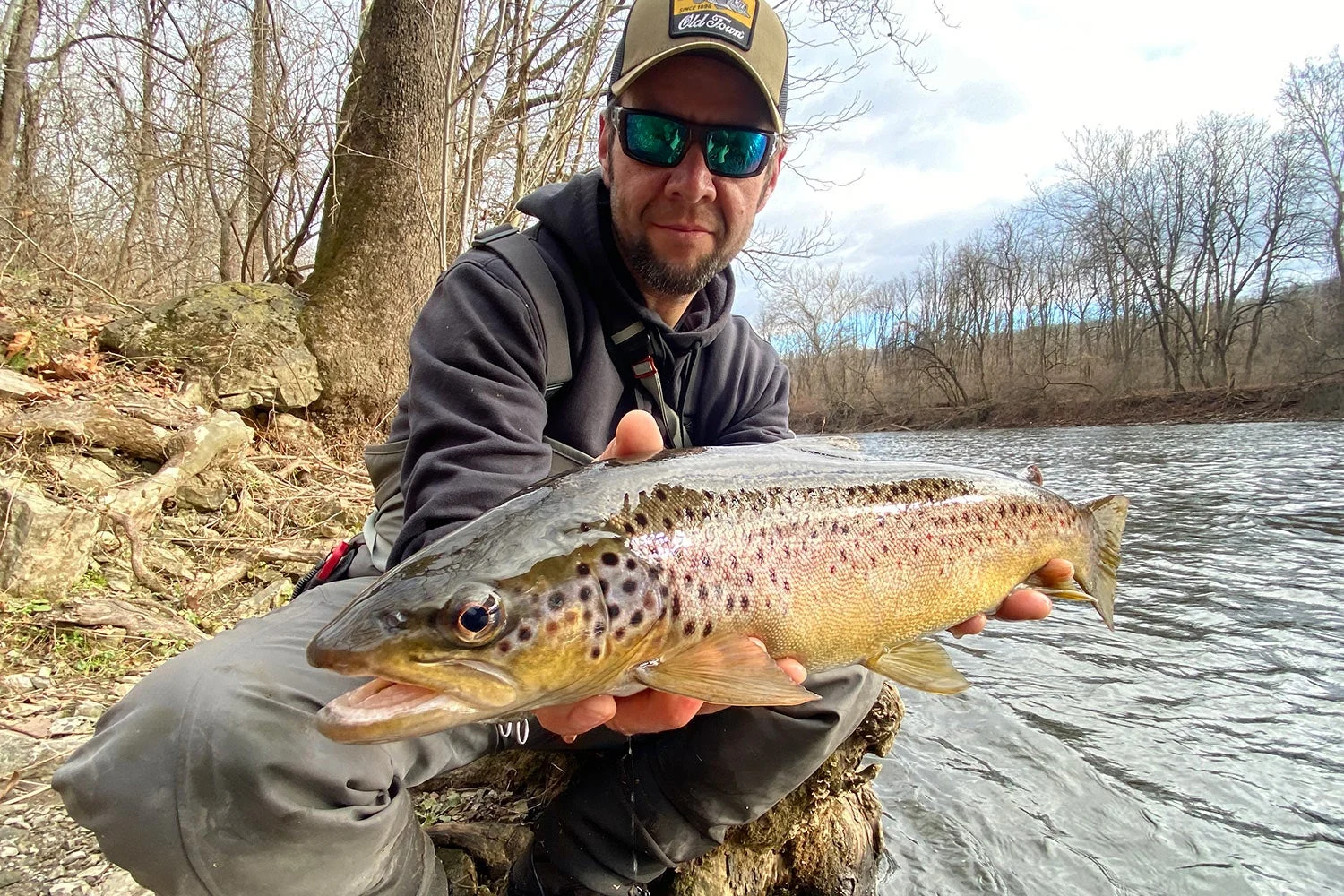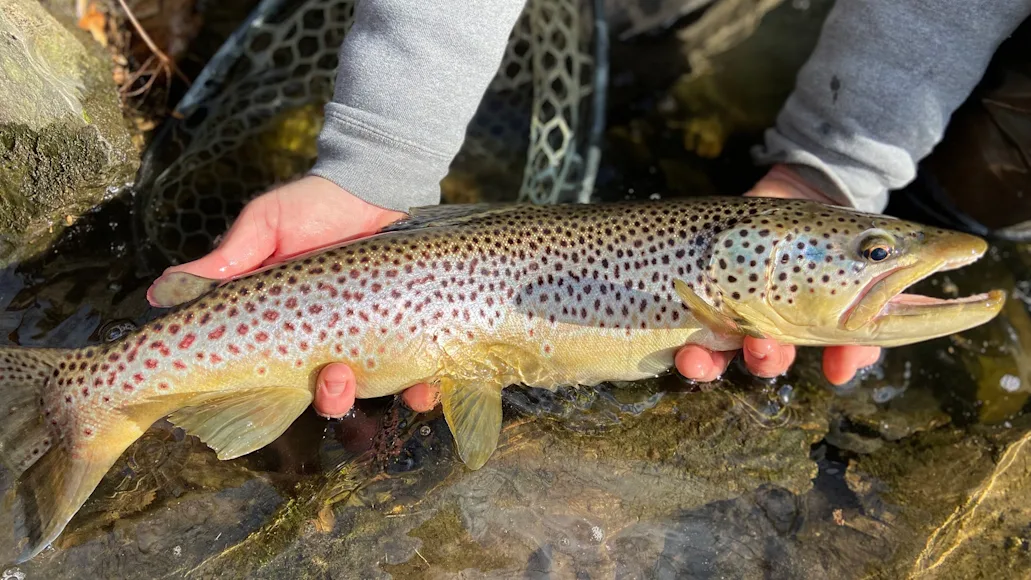THE FIRST TIME I fished the lower Madison River, I felt small. I was 18 years old and had never been out West—and though I’d grown up trout fishing on the East Coast, I had never done so on a river big enough to accommodate drift boats. In the elevated, post-runoff flows of June, wading was limited. I could take only a few steps out and was quickly overwhelmed by a feeling of inadequacy. The best I could hope for was a willing trout in my casting zone—a meager 30-foot semicircle from the bank. Up- and downstream, as far as I could see, the water appeared to be the same depth and speed. Meanwhile, drift boat after drift boat floated by. Every so often I’d hear a “Woot!” as an angler onboard set into a fish. To say I was jealous is an understatement. At that moment, and at that age, I longed for smaller water.
But all these years later, I’ve come to discover that wading anglers have advantages on big rivers that boaters don’t. Unlocking those advantages, however, starts with a willingness to be a little uncomfortable.
Heavy Reading
Small streams are so much more manageable for wading anglers because they’re easier to digest. Features like pools, riffles, eddies, and current breaks often exist within eyeshot of each other. It takes little effort to deduce where the fish might be holding. And if you’re wrong, you can cover plenty of water, reading the flow and structure as you go, until you find them. What many foot anglers don’t understand is that everything they know about where fish live on a small stream also applies to a big river. It’s just that one reads like a short story and the other a novel—the latter takes more time and dedication to finish, but I’d argue you often end up enjoying a more satisfying story.
What intimidates waders on big water more than anything is simply figuring out where to start. To do that, you first have to visualize the section of river you want to target as a small stream—and one of the best ways to do that is with Google Maps. Zoom out and imagine you’re looking at a much smaller piece of water. Suddenly, it begins to look a lot more like the streams you know, and, again, the rules don’t change.
An inside turn, as an example, will have depth and softer flow, whether that turn is a quarter mile long or 100 feet. A bank downstream of a choke point where the flow increases will likely have a scoured, sloping edge, whether the river is 30 feet or 100 yards across.
Not the Same Boat
Once I started fishing from drift boats, it was the only way I wanted to target trout. For years I believed that the most efficient way to catch big fish was to cover the maximum amount of water possible. Eventually, I bought my own drift boat, and if I wasn’t rowing it on one of the big East Coast trout or smallmouth rivers, I was on a buddy’s boat fishing from his rig. What I love about several of these rivers is that they don’t boast the numbers of fish you’d find on the Madison. You have to work for your bites, and I enjoy that challenge. For years, we considered catching five or six wild trout in a single float a productive day. It wasn’t until a good friend and staunch foot fisherman convinced me to leave the boat home and hit some of these same waters on foot that I realized just how many fish we weren’t catching.
His theory is that during a float, you may be covering more water, but you’re sticking a fish and moving along, potentially leaving many more in the same area on the table. If your home water is the Green River, which boasts an incredible number of trout per square mile, moving may not be a major disadvantage. But in an average big river, it’s not uncommon to find fish in pockets. Put another way: If you find one fish, there are probably more in the same place.

Learning how to wade-fish big rivers can deliver big—and buttery—results. Courtesy of Joe Cermele
The first time I wade-fished a river that I usually float, my friend and I landed five trout in the first spot alone—and never cast outside a 100-foot stretch where the bank sloped off below a long riffle that ran the width of the river. I’d caught plenty of trout in the same spot from a boat—but never more than one, because I was always eager to float on to the next piece of fishy water. What I also learned that day was that attacking big water on foot requires a reshuffling of your approach to wade fishing.
Stick and Don’t Move
Success lies in commitment. You have to go into the game knowing and accepting that you will not be able to cover as much water as you can on a small stream. Next, you must commit to putting in time at the access point you choose and not basing your assessment on 10 casts. You have no choice but to pick that starting location with the gut instinct you’ve honed on smaller water, but once you’re there, be methodical.
I always like to start with a technique that covers the maximum amount of water. If I’m spinfishing, that’s usually a spinner or jerkbait. If I’m fly fishing, it’s a big streamer. Think of it like surveillance work. Map out the stretch of water you think should be holding trout, start at the upstream end, and slowly work your way downstream. Deconstruct the area as one with a beginning and ending point, and just focus on that one section. A grab is preferred, but I’m happy with even a bump or flash. Any sign of life tells you the area is worth committing to for the long haul.
If aggressive methods aren’t producing, you can whittle down your approach to something more intimate, like a jig or nymph. The bottom line is that once you connect or see life, don’t leave too soon. But if the spot does seem fishless, don’t get hung up on moving around that same stretch for any longer than is necessary. If you noticed another enticing area up the road, hop in the truck. Realize that with big water, you’re trying to develop a milk run of productive spots no differently than you would on a small stream. It’s just that those hotspots might be miles apart instead of a few hundred feet.
Big Pros, Little Cons
Whatever you do when attacking a big river on foot, don’t be a cowboy. As much as you might want to cross to that island or wade to the center of that run, safety should be priority number one. It’s also worth mentioning that while I wear waders to make getting where I want to be on a big river easier, once I’m in a spot, I rarely get my knees wet. So many anglers believe the key to glory is getting out just a little farther and landing a lure behind the rock that’s just out of range. But the reality is there are usually plenty of fish within a range that doesn’t force you to get even your feet wet.
In many cases, those fish are often much larger than your average trout or bass on a small stream. Big rivers simply grow bigger fish. It’s a tremendous perk to learning these more daunting waters, but solitude plays a role as well. Most of the smaller trout streams in the area where I grew up are more pressured now than ever. I’m certain I’m not the only person who can say this about his local trout streams, and it’s likely this pressure will only continue to increase. It’s fair to say that these days, it’s easier for me to find quality fish on big water simply because they’re less pressured and less wary. Even on rivers with heavy boat traffic, fish are less expectant of a stealthy bank approach.
I’ll never give up my drift boat, as it has its own advantages throughout the season, but I’ve really come to enjoy putting boots on the ground now and again. And when I stick a big fish on foot in a river that makes me feel small, I find it more gratifying than catching 10 little ones from the boat.
_Read more F&S+
stories._






